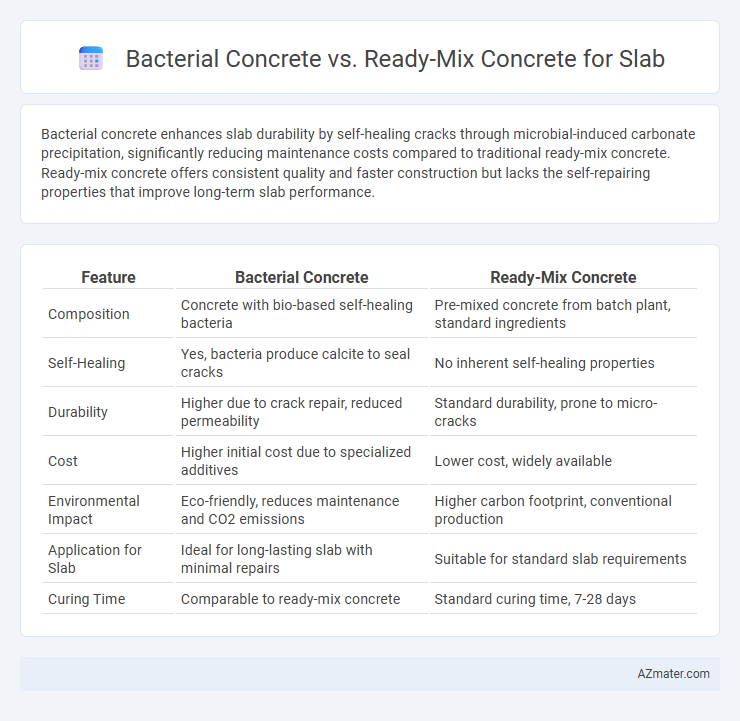Bacterial concrete enhances slab durability by self-healing cracks through microbial-induced carbonate precipitation, significantly reducing maintenance costs compared to traditional ready-mix concrete. Ready-mix concrete offers consistent quality and faster construction but lacks the self-repairing properties that improve long-term slab performance.
Table of Comparison
| Feature | Bacterial Concrete | Ready-Mix Concrete |
|---|---|---|
| Composition | Concrete with bio-based self-healing bacteria | Pre-mixed concrete from batch plant, standard ingredients |
| Self-Healing | Yes, bacteria produce calcite to seal cracks | No inherent self-healing properties |
| Durability | Higher due to crack repair, reduced permeability | Standard durability, prone to micro-cracks |
| Cost | Higher initial cost due to specialized additives | Lower cost, widely available |
| Environmental Impact | Eco-friendly, reduces maintenance and CO2 emissions | Higher carbon footprint, conventional production |
| Application for Slab | Ideal for long-lasting slab with minimal repairs | Suitable for standard slab requirements |
| Curing Time | Comparable to ready-mix concrete | Standard curing time, 7-28 days |
Introduction to Bacterial Concrete and Ready-Mix Concrete
Bacterial concrete incorporates specific microbes that precipitate calcium carbonate, enhancing self-healing properties and durability by sealing cracks autonomously. Ready-mix concrete is industrially prepared and delivered to construction sites, ensuring consistent quality, uniformity, and time efficiency for slab construction. Both types optimize structural integrity, but bacterial concrete offers innovative crack resistance while ready-mix concrete excels in standardized application.
Composition and Manufacturing Process
Bacterial concrete incorporates specific bacteria strains, typically Bacillus subtilis or Bacillus pasteurii, embedded with nutrients like calcium lactate to induce self-healing properties by precipitating calcium carbonate, enhancing crack resistance and durability. Ready-mix concrete consists mainly of cement, aggregates (sand and gravel), water, and chemical admixtures, produced in batching plants ensuring consistent mix quality and delivered promptly for on-site placement. The manufacturing of bacterial concrete involves culturing bacteria and mixing them evenly with cement and aggregates, whereas ready-mix concrete is manufactured through precise proportioning and mixing of raw materials followed by immediate transportation to construction sites for slab casting.
Mechanism of Action: Self-Healing vs Traditional Binding
Bacterial concrete utilizes specific microorganisms that precipitate calcium carbonate, effectively filling cracks and enhancing durability through a self-healing mechanism, whereas ready-mix concrete relies on traditional cement hydration processes to bind aggregates and provide structural integrity. The self-healing action in bacterial concrete reduces maintenance costs and extends the lifespan of slabs by autonomously repairing microcracks. Ready-mix concrete slabs, while offering consistent strength and ease of placement, lack the intrinsic ability to heal cracks, making them more susceptible to deterioration over time.
Durability and Lifespan Comparison
Bacterial concrete utilizes microbial-induced calcite precipitation to self-heal cracks, significantly enhancing durability and extending the slab's lifespan beyond 50 years compared to traditional ready-mix concrete, which typically lasts 30-40 years under similar conditions. The self-healing properties of bacterial concrete reduce permeability and mitigate corrosion in reinforcing steel, leading to improved long-term structural integrity. Ready-mix concrete offers consistent quality and rapid installation but lacks inherent crack repair mechanisms, making it more susceptible to environmental damage over time.
Compressive Strength and Load-Bearing Capacity
Bacterial concrete exhibits enhanced compressive strength due to microbial-induced calcite precipitation, which fills micro-cracks and pores, increasing the material's density and durability. Ready-mix concrete offers standardized compressive strength based on mix design and curing but may lack the self-healing benefits found in bacterial concrete. The load-bearing capacity of bacterial concrete surpasses traditional ready-mix concrete, providing improved structural resilience in slab applications through increased crack resistance and longevity.
Crack Resistance and Maintenance Needs
Bacterial concrete significantly enhances crack resistance by utilizing microbial-induced calcite precipitation to heal microcracks autonomously, reducing the risk of structural damage. Ready-mix concrete relies on traditional compounds and admixtures, showing moderate crack resistance but often requires frequent maintenance and repair to address surface fissures. Maintenance needs for bacterial concrete are lower due to its self-healing properties, which extend slab durability and reduce lifecycle costs compared to ready-mix concrete.
Environmental Impact and Sustainability
Bacterial concrete significantly reduces carbon footprint by utilizing microbial-induced calcite precipitation to heal cracks, extending slab durability and lowering maintenance emissions compared to traditional ready-mix concrete. Ready-mix concrete production involves high energy consumption and CO2 emissions due to cement manufacturing, whereas bacterial concrete offers enhanced sustainability by minimizing material use and promoting self-repair mechanisms. Incorporating bacterial concrete in slabs supports green building certifications and aligns with environmental goals by reducing waste and enhancing lifespan.
Cost Analysis and Economic Feasibility
Bacterial concrete demonstrates higher initial costs than ready-mix concrete due to the expense of microbial additives and bio-agent integration, but offers long-term economic benefits through reduced maintenance and enhanced durability of slab structures. Ready-mix concrete provides lower upfront costs and quicker installation, making it economically feasible for short-term projects or where budget constraints are critical. Cost analysis reveals bacterial concrete's value in infrastructure requiring longevity and self-healing properties, offsetting initial investment by minimizing repair costs and extending slab lifespan.
Applications in Slab Construction
Bacterial concrete enhances slab durability and self-healing properties by reducing crack formation, making it ideal for long-lasting industrial floors and infrastructure projects prone to environmental stress. Ready-mix concrete offers consistent quality and faster installation, suitable for large-scale residential and commercial slab construction requiring quick turnaround and uniform strength. Both materials serve slab construction efficiently, with bacterial concrete favored for sustainability and maintenance, while ready-mix concrete excels in standardized application and time-sensitive projects.
Conclusion: Choosing the Right Concrete for Slabs
Bacterial concrete enhances durability and self-healing properties, making it suitable for long-term slab integrity and crack resistance. Ready-mix concrete offers consistent quality, rapid installation, and cost-efficiency, ideal for large-scale projects requiring fast turnaround times. Selecting the right concrete depends on project priorities, balancing durability needs with budget and construction speed.

Infographic: Bacterial concrete vs Ready-mix concrete for Slab
 azmater.com
azmater.com